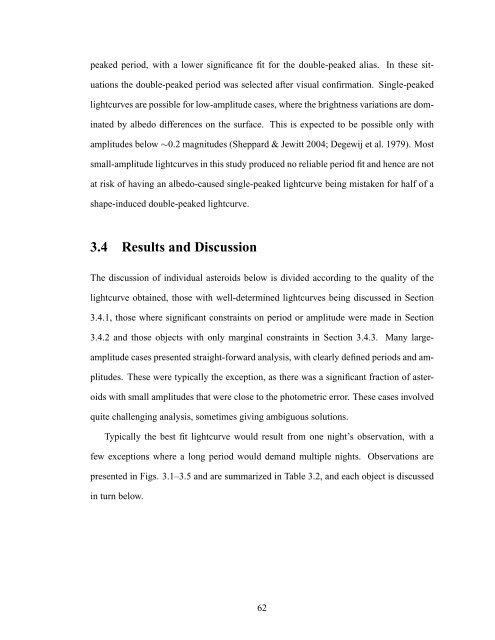Forming Binary Near-Earth Asteroids From Tidal Disruptions
Forming Binary Near-Earth Asteroids From Tidal Disruptions
Forming Binary Near-Earth Asteroids From Tidal Disruptions
You also want an ePaper? Increase the reach of your titles
YUMPU automatically turns print PDFs into web optimized ePapers that Google loves.
peaked period, with a lower significance fit for the double-peaked alias. In these situationsthe double-peaked period was selected after visual confirmation. Single-peakedlightcurves are possible for low-amplitude cases, where the brightness variations are dominatedby albedo differences on the surface. This is expected to be possible only withamplitudes below ∼0.2 magnitudes (Sheppard & Jewitt 2004; Degewij et al. 1979). Mostsmall-amplitude lightcurves in this study produced no reliable period fit and hence are notat risk of having an albedo-caused single-peaked lightcurve being mistaken for half of ashape-induced double-peaked lightcurve.3.4 Results and DiscussionThe discussion of individual asteroids below is divided according to the quality of thelightcurve obtained, those with well-determined lightcurves being discussed in Section3.4.1, those where significant constraints on period or amplitude were made in Section3.4.2 and those objects with only marginal constraints in Section 3.4.3. Many largeamplitudecases presented straight-forward analysis, with clearly defined periods and amplitudes.These were typically the exception, as there was a significant fraction of asteroidswith small amplitudes that were close to the photometric error. These cases involvedquite challenging analysis, sometimes giving ambiguous solutions.Typically the best fit lightcurve would result from one night’s observation, with afew exceptions where a long period would demand multiple nights. Observations arepresented in Figs. 3.1–3.5 and are summarized in Table 3.2, and each object is discussedin turn below.62












